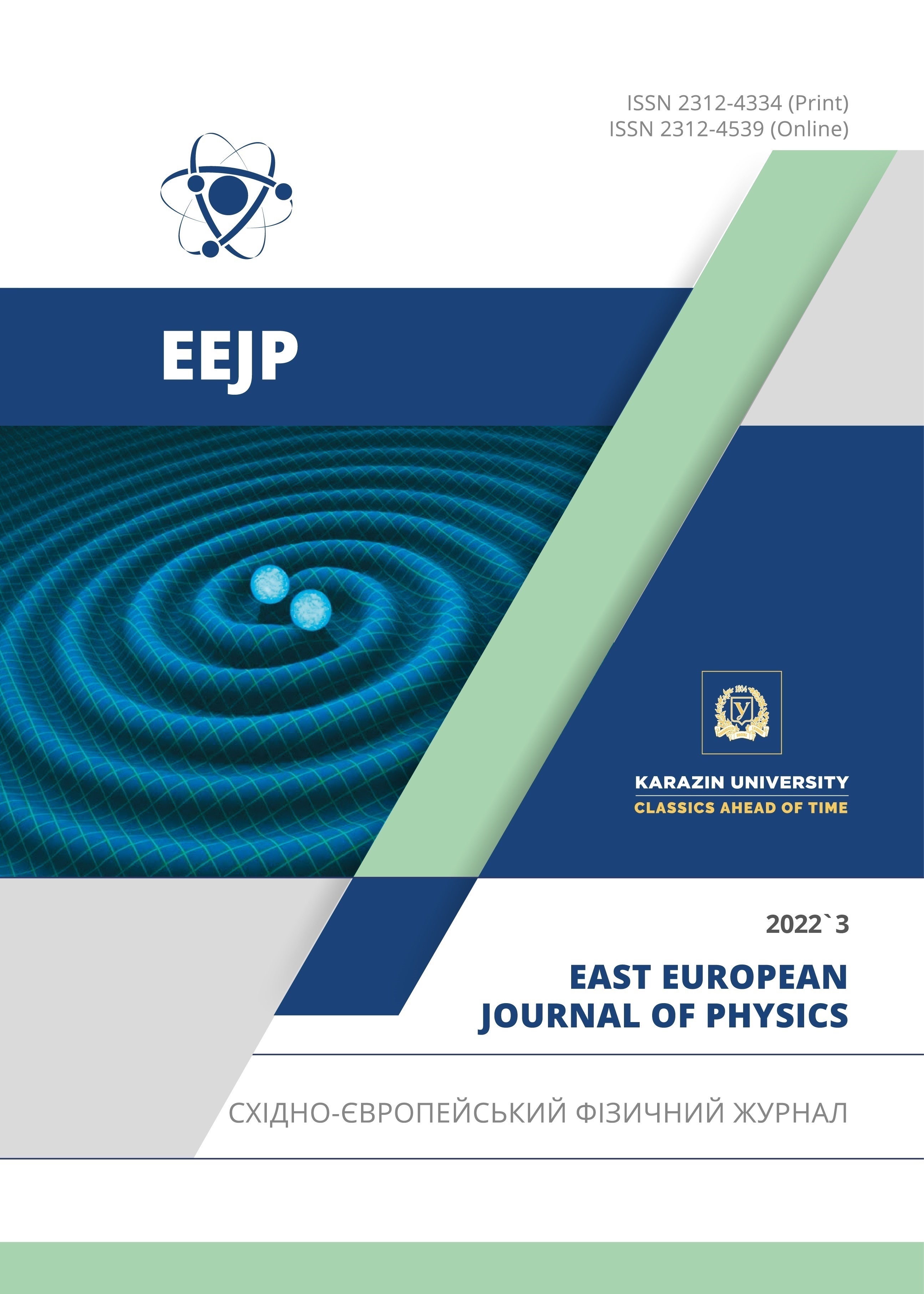Effects of Gravitational Field of a Topological Defect on Statistical Properties of Heavy Quark-Antiquark Systems
Abstract
In this paper, we determine eigen energies, eigenfunctions and statistical properties of non-relativistic heavy quarkonia interacting with the extended Cornel potential within a space-time generated by a cosmic-string. We extend the Cornel potential by adding the inverse square potential plus the quadratic potential. We have calculated the energy eigenvalues and the corresponding eigenstates using the Extended Nikiforov-Uvarov (ENU) method. Then, based on the equation of energy spectra, the thermodynamic properties like partition function, entropy, free energy, mean energy and specific heat capacity are calculated within the space-time of a cosmic-string. In the next step, we investigate the influence of the cosmic-string parameter on quantum states of heavy quarkonia and their statistical properties.
Downloads
References
L.R. Ribeiro et al, Phys. Lett. A, 348, 135 (2006). https://doi.org/10.1016/j.physleta.2005.08.046
K. Bakke, Int. J. Mod. Phys. A, 26, 4239 (2011). https://doi.org/10.1142/S0217751X11054437
Y. Aharonov, and D. Bohm, Phys. Rev. 115, 485 (1959). https://doi.org/10.1103/PhysRev.115.485
K.W.B. Kibble, J. Phys. A: Math. Gen. 9(8), 1387 (1976). https://doi.org/10.1088/0305-4470/9/8/029
K.W.B. Kibble, Phys. Rev. D, 26(2), 435 (1982). https://doi.org/10.1103/PhysRevD.26.435
A. Vilenkin, and E.P.S. Shellard, Cosmic Strings and Other Topological Defects, (Cambridge University Press, Cambridge, U.K., 1994).
J. Rocher, Thèse de Doctorat, Contraintes cosmologiques sur la physique de l'univers primordial, Universit de Paris XI-Orsay, 2005.
L. Bergström, and A. Goobar, Cosmology and Particle Astrophysics, 2nd edition (Springer, 2006).
A.-C. Davis, and T.W. Kibble, Contemp. Phys. 46, 313 (2005). https://doi.org/10.1080/00107510500165204
N.G. Marchuk, Nuovo. Cimento. B, 115, 11 (2000). https://doi.org/10.48550/arXiv.math-ph/0010045
C. Furtado, V.B. Bezerrae, and F. Moraes, Phys. Lett. A, 289, 160 (2001). https://doi.org/10.1016/S0375-9601(01)00615-6
C. Furtado, B.G.C. da Cunha, F. Moraes, E.R.B. Mello, and V.B. Bezzerra, Phys. Lett. A, 195, 90 (1994), https://doi.org/10.1016/0375-9601(94)90432-4
J. Audretsch, and A. Economou, Phys. Rev. D, 44, 3774 (1991). https://doi.org/10.1103/PhysRevD.44.3774
D.D. Harari, and V.D. Skarzhinsky, Phys. Lett. B, 240, 322 (1990). https://doi.org/10.1016/0370-2693(90)91106-L
J.R. Gott III, Astrophys. 288, 422 (1985). https://adsabs.harvard.edu/pdf/1985ApJ...288..422G
V.B. Bezerra, Phys. Rev. D, 35, 2031 (1987). https://doi.org/10.1103/PhysRevD.35.2031
W. Florkowski, Phenomenology of Ultra-Relativistic Heavy-Ion Collisions, (World Scientific Singapore, 2010), pp. 416.
U. Kalade, and B.K. Patra, Phys. Rev. C, 92, 024901 (2015). https://doi.org/10.1103/PhysRevC.92.024901
T. Matsui, and H. Satz, Phys. Lett. B, 178, 416 (1986). https://doi.org/10.1016/0370-2693(86)91404-8
R.C. Hwa, and X.N. Wang, editors, Quark-Gluon Plasma 3, (World Scientific Publishing, 2004), pp. 788.
V.S. Filinov, M. Bonitz, Y.B. Ivanov, M. Ilgenfritz, and V.E. Fortov, Contrib. Plasma Phys. 55, 203 (2015). https://doi.org/10.1002/ctpp.201400056
M. Schleif, and R. Wunsch, Eur. Phys. J. A, 1, 171 (1998). https://doi.org/10.1007/s100500050046
M. Abu-Shady, Inter. J. Theor. Phys. 52, 1165 (2013). https://doi.org/10.1007/s10773-012-1432-z
M. Abu-Shady, Inter. J. Theor. Phys. 54, 1530 (2015). https://doi.org/10.1007/s10773-014-2352-x
D. Nga Ongodo, J.M. Ema'a Ema'a, P. Ele Abiama, and G.H. Ben-Bolie, Int. J. Mod. Phys. E, 28, 1950106 (2019). https://doi.org/10.1142/S0218301319501064
Al-Jamel, Mod. Phys. Lett. A, 33, 1850185 (2018). https://doi.org/10.1142/S0217732318501857
H. Karayer, D. Demirhan, and F. Büyükilic, J. Math. Phys. 59, 053501 (2008). https://doi.org/10.1063/1.5022008
M.D. Katanaev, and I.V. Volovich, "Theory of defects in solids and three-dimensional gravity", Annals of Physics, 216(1), 1 1992. https://doi.org/10.1016/0003-4916(52)90040-7
C. Furtado, and F. Moraes, Phys. Lett. A, 188(4-6), 394 (1994). https://doi.org/10.1016/0375-9601(94)90482-0
C.R. Muniz, V.B. Bezerra and M.S. Cunha, Ann. Phys. 350, 105 (2014). https://doi.org/10.1016/j.aop.2014.07.017
V.F. Mukanov, H.A. Feldman, and R.H. Brandenberger, Physical Report 215, 203 (1992). https://doi.org/10.1016/0370-1573(92)90044-Z
J.L. Domenech-Garret, and M.A. Sanchis-Lozano, Physics Letters B, 669(1), 52 (2008). https://doi.org/10.1016/j.physletb.2008.09.021
Y. Cançelik, and B. Gönül, Mod. Phys. Lett. A, 29, 1450170 (2014). https://doi.org/10.1142/S0217732314501703
M. Modarres, and A. Mohamadnejad, Phys. Part. Nucl. Lett. 10, 99 (2013). https://doi.org/10.1134/S1547477113020106
M. Modarres, and H. Gholizade, Int. J. Mod. Phys. E, 17, 1335 (2008). https://doi.org/10.1142/S0218301308010453
A.N. Ikot, B.C. Lutfuoglu, M.I. Ngweke, M.E. Udoh, S. Zare, and H. Hassanabadi, Eur. Phys. J. Plus, 131, 419 (2016). https://doi.org/10.1140/epjp/i2016-16419-5
W.A. Yahua, and K.J. Oyewumi, J. Asso. Arab. Univ. Bas. App. Scie, 21, 53 (2016). https://doi.org/10.1016/j.jaubas.2015.04.001
H. Hassanabadi, and M. Hosseinpoura, Eur. Phys. J. C, 76, 553 (2016). https://doi.org/10.1140/epjc/s10052-016-4392-2
Copyright (c) 2022 André Aimé Atangana Likéné, Ali Zarma, Dieudonné Nga Ongodo, Jean Marie Ema'a Ema'a, Patrice Ele Abiama

This work is licensed under a Creative Commons Attribution 4.0 International License.
Authors who publish with this journal agree to the following terms:
- Authors retain copyright and grant the journal right of first publication with the work simultaneously licensed under a Creative Commons Attribution License that allows others to share the work with an acknowledgment of the work's authorship and initial publication in this journal.
- Authors are able to enter into separate, additional contractual arrangements for the non-exclusive distribution of the journal's published version of the work (e.g., post it to an institutional repository or publish it in a book), with an acknowledgment of its initial publication in this journal.
- Authors are permitted and encouraged to post their work online (e.g., in institutional repositories or on their website) prior to and during the submission process, as it can lead to productive exchanges, as well as earlier and greater citation of published work (See The Effect of Open Access).








